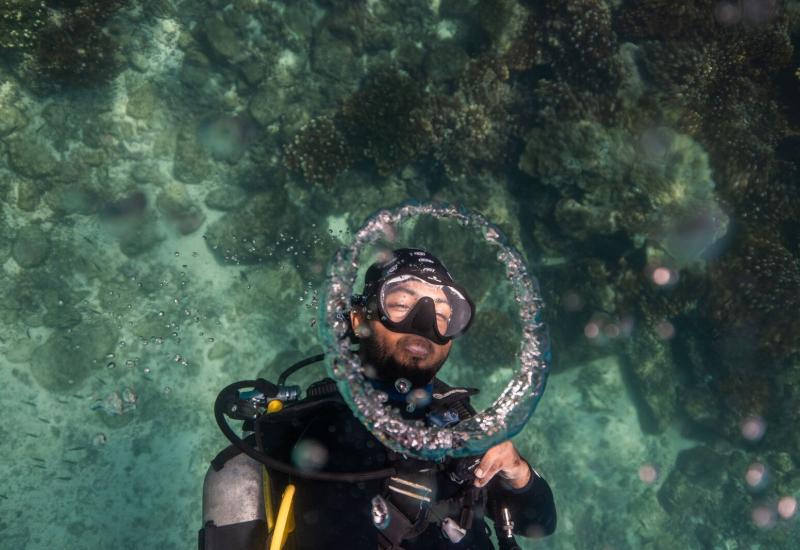How to Dive Sund Rock, Washington

Courtesy Lee Myron PhotoA giant Pacific octopus drops its camouflage to reveal its natural red-amber coloring
As an underwater photographer, half the battle is finding life to photograph. That is not a problem at Sund Rock! With its marine preserve status, you can see many creatures, including wolf eels, giant Pacific octopuses, lingcod and more!”
Lee Engebretson, a PADI Open Water Scuba Instructor and underwater photographer and videographer who has been diving in the Pacific Northwest for 20 years, delights in the diversity of wildlife residing at Sund Rock Marine Preserve in the Hood Canal, a waterway just west of Seattle.
“People come from all over the world to dive the Hood Canal,” says Katherine Yackel, PADI Course Director and co-owner of YSS Dive in Hoodsport, Washington, where Engebretson is an instructor. “It is actually a fjord, not a canal!”
“The waterway is unique— it’s one of the very few fjords in the continental United States,” adds John Yackel, IDC Staff Instructor and co-owner with Katherine. “It’s very deep—500 or 600 feet—not far from shore.”
Related Reading: Top Editing Software and Tools for Underwater Photographers
Sund Rock has a long and storied history as a lush coastal site along the cold, deep waters of the fjord. Cindy Sund’s family presence there stretches back to 1889.
“Just about every day, the divers are coming back talking about what they saw,” says Sund, owner and steward of the property.
A few generations ago, this would not have been the case. Sund’s grandfather had a fraught relationship with divers who didn’t respect the property and overharvested local lingcod and rock cod.

Courtesy Lee Myron PhotoA lion’s mane jellyfish drifts through the murky water
“Divers used to call it barren, like a desert, when I was in high school,” explains Sund. Working with her father, Sund advocated for welcoming divers back to the property after it was designated as a protected area in the mid-1980s.
“Because they have not allowed the fishing, the wildlife has really started to come back, [including] the giant Pacific octopus and wolf eels,” Sund says.
On the preserve’s website, Sund describes the rich history of the homestead and lays out a contract of sorts for today’s divers looking to explore this special part of the Hood Canal. Essentially, the idea is that visitors take nothing and leave nothing.
“The community is really respectful of the marine life, which is really neat,” says Katherine.
That community consists of what Sund calls a new demographic of divers who are keen wildlife observers and passionate about preserving Sund Rock. Sund, who lives on the property, appreciates the Yackels’ effort to establish a sense of responsibility while educating divers to become instructors.
Related Reading: Mastering the Art of Cephalopod Photography

Courtesy Lee Myron PhotoA wolf eel stealthily snatches its next meal.
Now, on the first Friday of every month, divers sign up through YSS to night dive. YSS also takes divers to experience Sund Rock on their Fjord Diver course.
“It’s really set up for divers,” says John. “Restrooms, changing stations and hot showers—for those brave enough to go in wetsuits.”
Parking has also been refreshed; however, Sund encourages carpooling as spaces are limited.
“While sea life in the Hood Canal is abundant in many places, access to some of the sites can be very difficult,” adds Engebretson. “Sund Rock, however, is a shore site that allows easy access.”
As Sund sees it, the local wildlife benefits the most from this evolving relationship with divers: “It’s a testament to [the idea that] if you take care of the environment, they will come back.”
Need To Know
Water Temps
46 to 50 degrees
Visibility
10 feet in summer, 30 feet in winter
Certifications
PADI Adventure Diver, PADI Dry Suit Diver
What to Bring
Drysuit recommended
When to Visit
Octopuses are more playful and sixgill sharks are present in summer.
Dive Shop
YSS Dive yssdive.com, Sund Rock Marine Preserve sundrock.com

Site Spotlight
Sund Rock Marine Preserve is one of the few places where you might spot a giant Pacific octopus while you learn how to scuba dive, says Katherine Yackel.
Giant Pacific octopuses (Enteroctopus dofleini), aka GPOs, are notorious residents of Sund Rock. When a GPO is not camoufl aged, divers can spot its red-amber hue in the waters of the northern Pacific. The GPO is the largest octopus species and has a lifespan of three to five years.
“Giant Pacific octopuses are my favorite,” adds John Yackel, who loves to educate divers about their life cycle: Males and females don’t live long after breeding. “[The mother] lays eggs and sits on them for months; she doesn’t eat, she just sits on her eggs.” It’s an incredible sight for divers.










